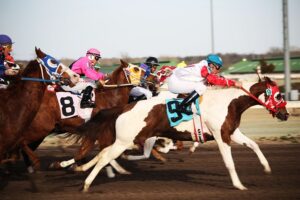There is nothing quite like the thrill of watching a horse race – the thundering hooves, the elegant and powerful animals, and the intense competition. Every time I watch them running so fast, I wonder, “Is a horse faster than a car?” Well, of course, the answer is no. But behind every successful race is a well-trained and fit horse. Endurance is a key factor in a horse’s ability to perform at its best on the track. However, this endurance doesn’t come from just one type of exercise. A well-rounded set of training that includes a variety of exercises is essential for building the strength and stamina needed for racing. Here are some key exercises to incorporate into your horse’s training regimen for optimal endurance.
Interval Training
 Interval training is a true game-changer when it comes to improving a racing horse’s endurance. This workout involves alternating between bursts of high-intensity exercise and rest periods or lower-intensity activity. The idea is to push the horse’s limits, allowing for short recovery periods before ramping up the intensity again. By incorporating interval training into your horse’s routine, you can help increase their cardiovascular fitness, build muscle strength, and boost overall performance on the track.
Interval training is a true game-changer when it comes to improving a racing horse’s endurance. This workout involves alternating between bursts of high-intensity exercise and rest periods or lower-intensity activity. The idea is to push the horse’s limits, allowing for short recovery periods before ramping up the intensity again. By incorporating interval training into your horse’s routine, you can help increase their cardiovascular fitness, build muscle strength, and boost overall performance on the track.
Sprinting Sprints
We’re not talking about some random sprint techniques low-class racing horses often do. It’s about the sprinting sprints – short bursts of intense speed not only help improve cardiovascular fitness but also strengthen muscles essential for racing. Sprinting sprints challenge the horse’s anaerobic system, pushing them to their limits and improving their ability to sustain high speeds during races. Incorporating variations in speed and distance can keep training sessions engaging and effective. Regularly monitoring the horse’s performance and adjusting training plans accordingly will help optimize results.

Hill Work
Now, let’s talk about another important exercise for building endurance. Hill work is all about the incline, which challenges the muscles and cardiovascular system in a way that flat surfaces can’t. It helps improve their strength, stamina, and overall performance on the track. When incorporating hill work into your horse’s training regimen, start gradually to prevent injury. Then, begin with gentle slopes before progressing to steeper inclines as they build up their endurance. The uphill climb engages different muscle groups compared to regular flat ground exercises, making it an effective way to enhance overall fitness levels. It also aims to develop coordination and balance, essential for navigating challenging terrains during races.
Long Slow Distance (LSD) Runs
 LSD runs are not about speed but rather about maintaining a consistent pace for an extended period. During LSD runs, horses develop mental toughness as they learn to sustain their effort over long distances. This type of training also aids in increasing muscle strength and overall conditioning. LSD runs allow horses to adapt to different terrains and weather conditions while minimizing the risk of injury from high-intensity workouts.
LSD runs are not about speed but rather about maintaining a consistent pace for an extended period. During LSD runs, horses develop mental toughness as they learn to sustain their effort over long distances. This type of training also aids in increasing muscle strength and overall conditioning. LSD runs allow horses to adapt to different terrains and weather conditions while minimizing the risk of injury from high-intensity workouts.
It is essential to incorporate a variety of training methods like LSD runs into a horse’s regimen to ensure well-rounded development and peak performance on race day. Remember, while building endurance is essential for racing horses, it’s equally important to prioritize their health and well-being. Make sure your horses are properly hydrated, fed nutritious meals, given adequate rest between training sessions, and receive regular veterinary check-ups. So lace up those riding boots and get ready to hit the training ground with these key exercises in mind – your equine athlete will thank you.

